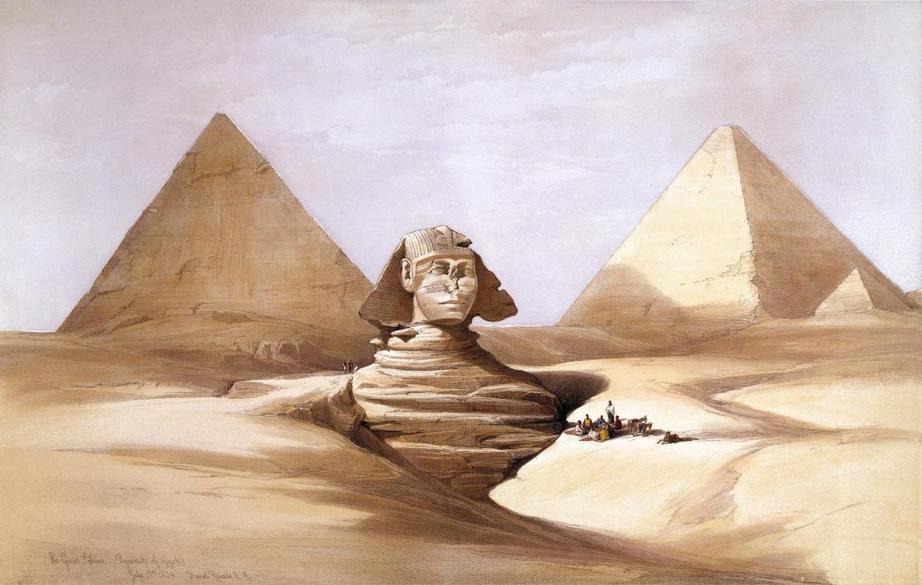The Kolbrin: on who built the Great Sphinx, and why
During the years I’ve been investigating the Kolbrin ̶ a mysterious set of books with no provenance ̶ one thing in particular has puzzled me. Surely, somewhere in those six Egyptian books, there ought to be a mention of the Great Sphinx ̶ after all, the Kolbrin is allegedly ancient, and the Great Sphinx is said to be older than time itself.
The Egyptian books contain no Greek-sounding names such as ‘Sphinx’, so they were probably written or copied before the advent of Ptolemaic rule. Finding references is a needle-in-a-haystack job which involves winkling out descriptions that sound like the Great sphinx and then trying them for size.
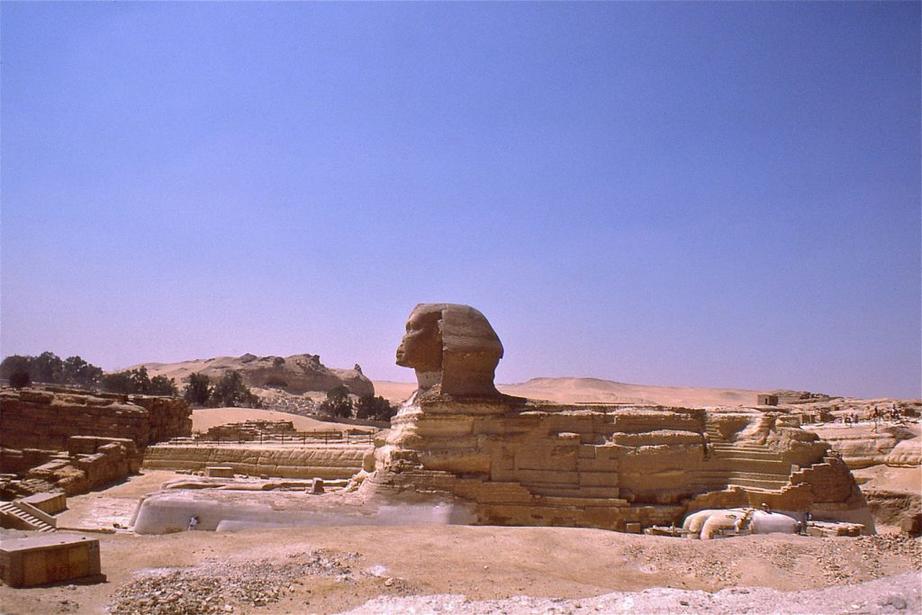
CC BY-SA 2.5, via Wikimedia Commons
But first, what do we know about the Sphinx? The monument faces east over the Giza plateau on the west bank of the Nile, taking the form of a ‘couchant’ limestone animal with paws outstretched in front. It is said to have a lion’s body and a human head. It is the oldest monumental sculpture in Egypt and it is huge ̶ 238 feet (73 metres) long from paw to tail and 66 feet (20 m) high from base to top of head ̶ its mouth alone is six-and-a-half feet wide.1
The Egyptologist Selim Hassan (1887–1961) who excavated the Sphinx during the 1930s believed that the Sphinx could be dated back
‘…to the first appearance of that god [Atun] whose name appears in the Pyramid Texts, along with those of Kheperi and Ra… On this basis, we can consider the Sphinx as one of the oldest of the Egyptian Gods, but unfortunately, we are building our hypothesis upon New Kingdom texts, which were written at a time when the Egyptians had forgotten the original traditions.’2
The Sphinx is now generally thought to have been built during the reign of the Pharaoh Khafre (2520-94 BC), with head and face carved into Khafre’s likeness.3 Centuries later, the pharaoh Thutmose IV (late-13th century BC) dreamed of the Sphinx, which prompted him to restore the monument and set an inscribed stone between the Sphinx’s front paws, now known as the ‘Dream Stela’.4
In 1993 the late lecturer and guide John Anthony West and the geologist Robert Schoch presented a TV documentary challenging the conventional c.2500 BC dating of the carving of the Sphinx; they contended that weathering on its body and the surrounding enclosure walls could only have been caused by prolonged rainfall between 10,000-5000 BC (West)5 or 5000-7000 BC (Schoch).6 Their documentary also suggested that the monument had been carved by an ancient advanced culture. Just how long the Sphinx has been in existence is now hotly disputed.
Legend has it that once, the Sphinx could speak. The Ancient Greeks said that it devoured all travellers who could not answer its riddle: ‘What walks on four legs in the morning, two legs at noon and three in the evening?’ The hero Oedipus gave the answer ‘Man,’ and the Sphinx, enraged at receiving the right answer, leapt down from the precipice where it sat and was dashed to pieces.7
The Sphinx’s names
What we know about the Sphinx’s names is summed up by Andrew Collins in Earthquest News: Andrew Collins Newsletter Vol. 12 No. 1 (May 2009), based in part on Graham Hancock and Robert Bauval’s 1996 book Keeper of Genesis. Hancock and Bauval have much to say about the Sphinx’s names, and note that its traditional 12th-century Arabic name was Abul-Hol (‘Father of Terror’), used by the writers Abdel-Latif and (later) El-Makrizi.8
Collins and Hancock and Bauval refer back to Selim Hassan, saying that foreigners known as ‘Canaanites’ (of Syro-Canaanite origin from the ancient city of Harran, now in modern Turkey) lived in Lower Egypt in the early second millennium BC and worshipped the Sphinx under the name Hwl. Collins has found New Kingdom inscriptions where the Sphinx is addressed as ‘Hauron’ (Horon/Chauron/Hwron) ̶ a Syro-Canaanite underworld deity. Hassan speculated that ‘Hauron’ was the origin of the Sphinx’s Arab name Abou-l Hwl, ‘Father of Terror’, interpreting hwl as a corruption of Hwron from the Semitic root hor = the bottom of a well, or hole, with abou a corruption of ancient Egyptian bw=place, therefore bw-hwron= the place of the god Hauron. Canaanite inscriptions mention Hauron being sent into the ‘chamber of darkness’, a form of underworld, to prevent demons entering the world.9
Collins says that among the civilizations of the Fertile Crescent, Hauron was identified with a deity called Nimru, meaning ‘panther’. In Akkado-Sumerian texts, Nimru was identified with a sky-figure in the form of a panther-griffin (half feline/half eagle) called UD.KA.DUH.A, made up of stars from the constellations Cygnus and Cepheus.10
The Ancient Egyptians called the Sphinx Hu and Hor-em-akhet ‘Horus of the Horizon’, a name originally linking the Sphinx to the rising sun.11 On the Dream Stela, Thutmose IV refers to the ‘Pyramids of Hor-em-akhet’, from which Selim Hassan deduced that the pharaoh considered the Sphinx to be older than the Pyramids.12 Another Egyptian name for the Sphinx was Seshep-ankh Atum (‘the living image of Atum’); the name ‘Sphinx’ used today is a Greek corruption of Sheshep-ankh.13
So the Sphinx’s names over the period of Egyptian civilisation have meant father, terror, the horizon, Horus, Atum, a protective underworld deity and a star-clustered hybrid beast. This assortment suggests many different ages and beliefs.
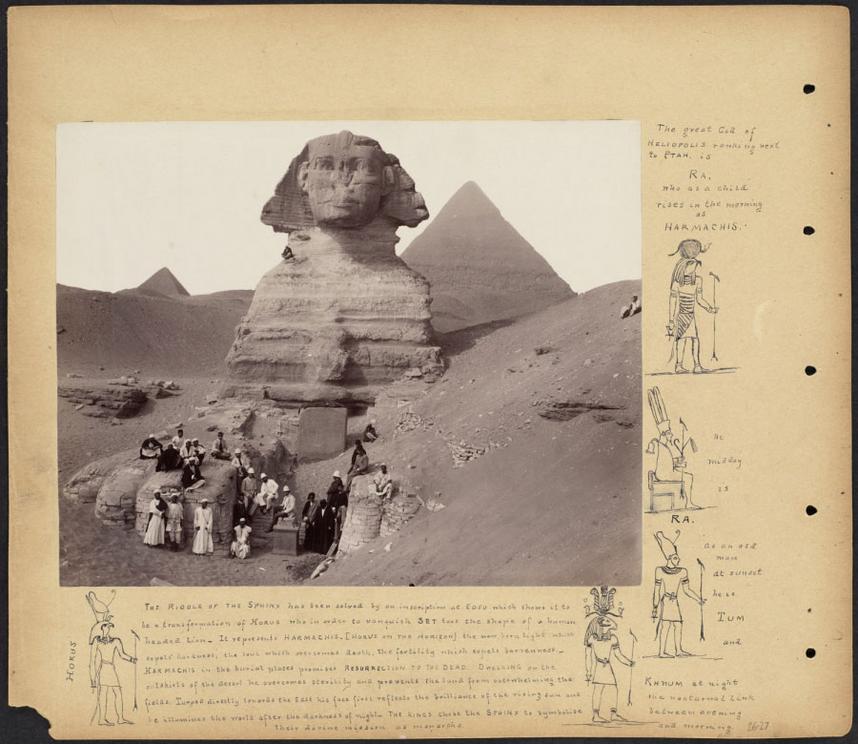
William Vaughn Tupper, Tupper Scrapbooks Collection, Boston Public Library
The Sphinx in the Kolbrin – 1
Two small pieces of text in the Kolbrin may refer to the Sphinx.
The first appears in the Book of Manuscripts and comes from a chapter written by a scribe called Emod, and refers back to a distant past when refugees arrived in Egypt. It reads:
‘It was the men of Zaidor who built the Great Guardian which ever watches, looking towards the awakening place of God. The day He comes not its voice will be heard.’
A picture emerges of something that forever sits in silence, watching and waiting for a sinister-sounding event to happen. The Great Guardian faces towards ‘the awakening place of God’ ̶ eastward to where the sun rises; this is echoed in the Sphinx’s traditional name Horemakhet/Harmakhet/Harmachis meaning ‘Horus in the horizon‘.
Why would the Sphinx be called ‘the Great Guardian’? In Egyptian mythology the ‘Great Guardian’ is the jackal-headed god Anubis who, like a watch-dog, guarded the entrance to the underworld, protected burial places and oversaw the weighing of the hearts of the dead.14 In early Egyptian times Anubis was associated with several cult centres including a northern Egyptian city called Zawty, meaning ‘Guardian’ (modern-day Asyut).15 Later it became known as Lycopolis ̶ ‘Wolf City’.16
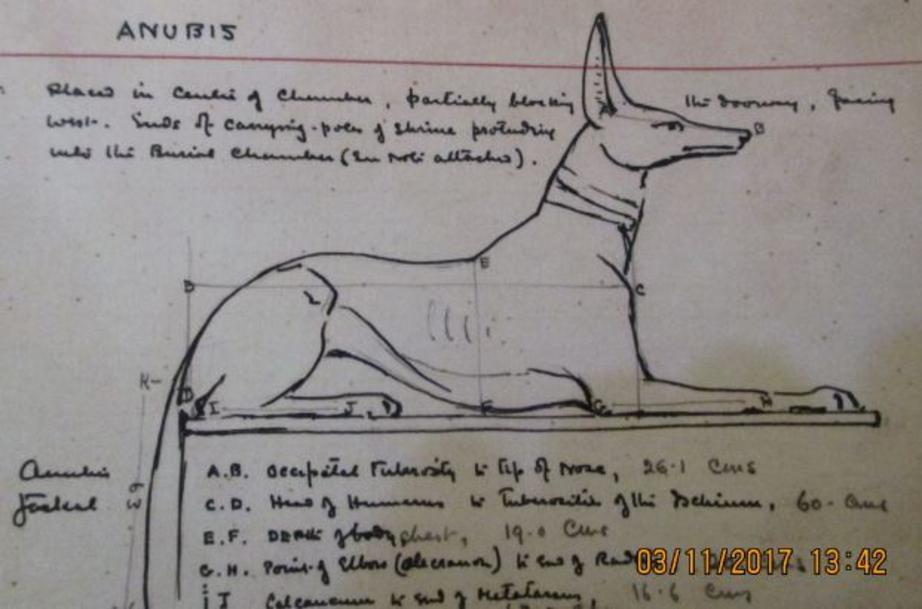
Original drawing by Howard Carter at his house in Luxor. Photo by YW
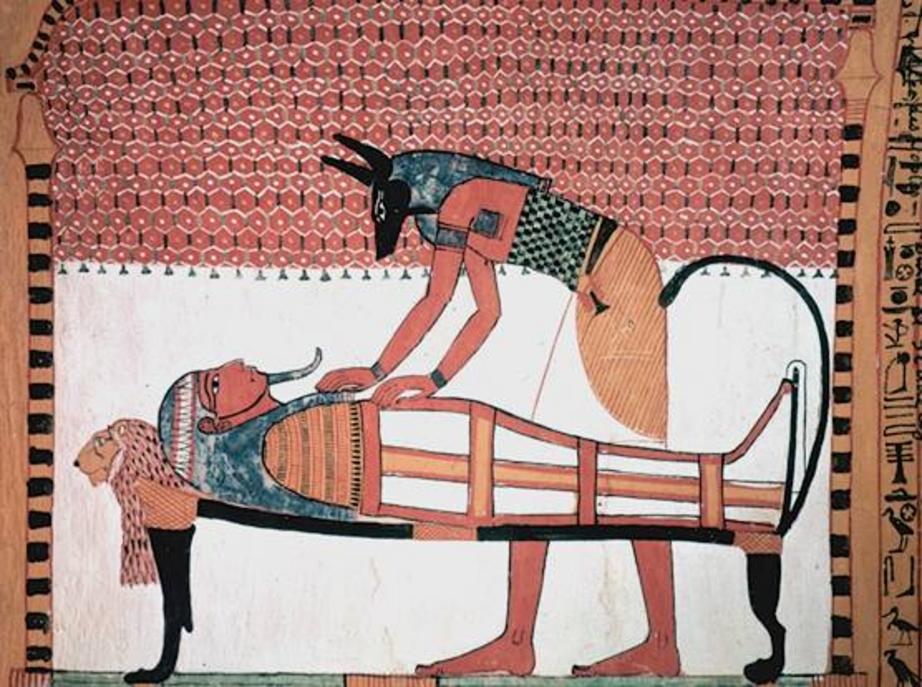
Anubis attending the mummy of the deceased – Public Domain
But what, you may ask, has the jackal god Anubis to do with the Sphinx? After all, everyone knows the Sphinx is a lion.
Or is it?
The investigative author Robert Temple believes that the Sphinx was originally carved in the form of the jackal Anubis. In The Sphinx Mystery he devotes an entire chapter to his controversial theory, saying:
‘The first time I went to Egypt and saw the Sphinx with my own eyes, I was deeply shocked… I had always been told that the Sphinx had the body of a lion with the head of a man, and I accepted that account as being true… This was one of those disillusioning moments in life, like realizing there is no Santa Claus, when all your hopes and dreams are stripped away from you… The Sphinx was something, but it certainly wasn’t a lion.’
Temple puts forward an interesting case for the Sphinx originally having been carved as an Egyptian jackal ̶ or, to be precise, what has been genetically identified as an African Golden Wolf. To show how the Sphinx could have been reworked with the disproportionately tiny head it now has, reproduced below is a drawing used in Temple’s book of the famous statue of Anubis found in Tutankhamun’s tomb with a scale drawing of the Sphinx’s much smaller, remodelled head set inside it.
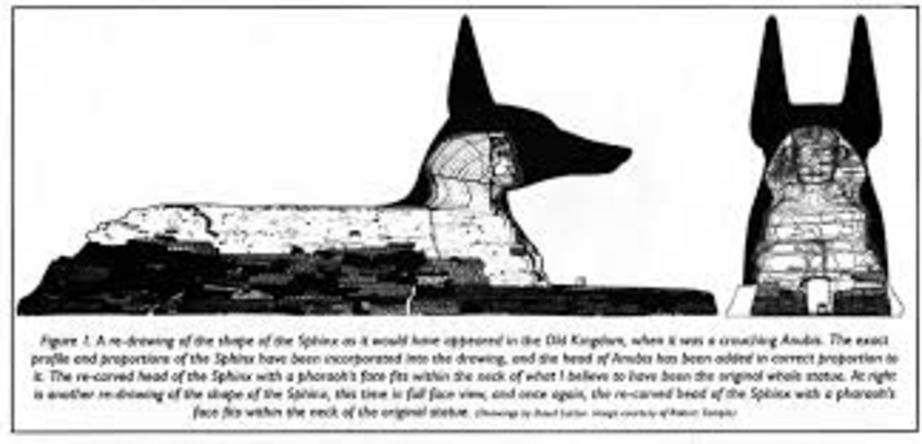
Drawings by David Sutton. Image courtesy of Robert Temple
Temple points out that one of the Sphinx’s many reconstructions involved filling in the once narrow, dog-like body of the Sphinx to make it more massive and leonine. He also notes that the monument’s thin, smooth lion tail is made entirely of bricks with no carved stone core at all, leading him to think that the tail may not be an original feature but was added at a later period as part of a ‘lionizing’ process. If there had been an original tail, he writes, ‘what we have now is largely or wholly a replacement or “tail transplant”‘.
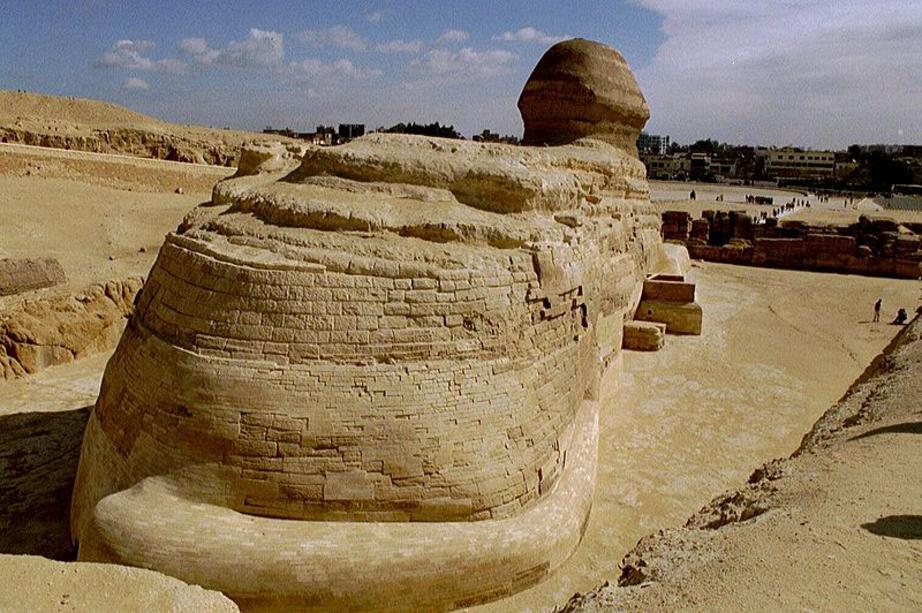
Whether the Sphinx was originally carved as a jackal or as a lion, ‘Great Guardian’ is an appropriate epithet for a creature guarding Giza’s sacred heights. Hassan says:
‘There seems little doubt that by the time of the New Kingdom, the Sphinx was regarded as a God of the dead, and guardian of the dead, an attribution which its situation at the entrance to the Necropolis rendered very suitable.’17
Collins points out that, as the temples themselves admit, the role of guardian to the duat-underworld was held by a lion (ru) and by a jackal. If, as inscriptions and folklore suggest, the Sphinx was later represented as a lion, then this cultural accretion only serves to accentuate its extreme age.
Those who built the Sphinx
Back to that first Kolbrin snippet:
‘It was the men of Zaidor who built the Great Guardian which ever watches, looking towards the awakening place of God. The day He comes not its voice will be heard.’
The ‘men of Zaidor’ are mentioned several times in the Kolbrin’s Book of Manuscripts.18 Described as ‘the Wise Ones from the East’, they are the second group of refugees to arrive in Egypt after a cataclysm had wiped out the people of Egypt and perhaps their own civilisation too.19 Many names in the Kolbrin have become skewed through centuries of translating and copying (for example, the pharaoh Akhnaten appears as ‘Nabihaton’, the vital essence hike appears as ‘hokew’), but usually the internal consonants of the word remain unchanged, so ‘Zaidor’ could well be a skewed version of the name ‘Poseida’. If it is, then the men of Zaidor came from a place the 20th-century ‘Sleeping Prophet’ psychic Edgar Cayce described as the largest island of the Atlantis archipelago.20 Mention psychic readings, and at once you find yourself on shaky ground, but Cayce is of interest here because one of his Atlantis readings mentions not only ‘Poseida’ but also another place-name ̶ ‘Amaki’; this sounds like the name ‘Ramakui’ which crops up several times in the Kolbrin. Ramakui/Amaki ̶ Zaidor/Poseida.21
The Kolbrin has more to tell about the men of Zaidor:
‘This was the land from whence man came, the Great One came from Ramakui and wisdom came from Zaidor. The people who came with Nadhi were wise in the ways of the seasons and in the wisdom of the stars. They read the Book of Heaven with understanding.
‘They covered their dead with potter’s clay and hardened it, for it was not their custom to place their dead in boxes.22
‘We dwell in a land of three peoples, but those who came from Ramakui and Zaidor were fewer in numbers. It was the men of Zaidor who built the Great Guardian which ever watches, looking towards the awakening place of God. The day He comes not its voice will be heard.’
When the final sentence is unpacked, something extraordinary emerges:
‘… the awakening place of God.’
This must refer to Ra, the Egyptian father-creator god who in his role as sun-god sailed across the heavens during the day in his ‘Barque of Millions of Years’, spent the night in the underworld and was reborn at dawn the next day.
‘The day he comes not…’
A day when the sun did not rise would surely spell disaster for the Earth.
‘… its voice will be heard’.
The Sphinx had a voice which would be heard when ‘he comes not’ ̶ that is, when the sun did not rise. What form could this ‘voice’ have taken? It sounds like an alarm of some kind. Was the Sphinx built with a sensor in its eastward-facing gaze so that if the sun did not rise in the east as usual, or if the sky blackened out the sun, or if the rising sun were to be outshone by a brighter light, the alarm would be triggered?
Why they built the Sphinx
Why would the sun not rise in the east? What would cause the Earth’s orbit to shift so that the sun rose from another direction?
Elsewhere, the Kolbrin tells of ‘the Destroyer’, a terrible cosmic event said to wreak havoc on the Earth at long, regular intervals, and says that the planets changed their position at the time the Destroyer appeared: ‘When ages pass, certain laws operate upon the stars in the Heavens. Their ways change, there is movement and restlessness, they are no longer constant…’23 The Kolbrin’s Annexed Scroll 1 says: ‘My land is old, a hundred and twenty generations have passed through it since Osireh brought light to men. Four times the stars have moved to new positions and twice the sun has changed the direction of his journey.’24 The sun rising in another direction is also mentioned by the 5th-century BC writer Herodotus and the 1st-century Latin author Pomponio Mela, who writes:
‘The Egyptian people pride themselves on being the most ancient people in the world. In their authentic annals… one may read that since they have been in existence, the course of the stars has changed direction four times, and that the sun has set twice in the part of the sky where it rises today.’
The Kolbrin also says that the Destroyer appeared at first light (‘Then, with the dawning, men saw an awesome sight. There, riding on a great black rolling cloud came the Destroyer’25… at ‘the rosy dawning of a newborn day… at the night end of the skyroof appeared the dread figure’26 ̶ more on the Destroyer later.)
Could an alarm inside the Sphinx have given rise to a tradition that it ‘spoke’? Was the Sphinx an early warning system? This is what the Kolbrin is saying.
If the Sphinx starts to sound like something out of Star Wars, bear in mind that the men of Zaidor under their leader Nadhi ‘were wise in the ways of the seasons and in the wisdom of the stars. They read the Book of Heaven with understanding.‘ From the legacy they left behind them in Egypt, it is clear that these men of Zaidor were a highly advanced people.
Yet another puzzle presents itself: why would the men of Zaidor build an early warning system in the form of a huge beast? The Kolbrin says they arrived in a country populated by human beings whose culture and knowledge had been totally destroyed by global cataclysm. All the adults had been killed by a plague which for some reason many of their children survived. These survivors, with nobody to teach them, wore animal skins, lived in holes in the ground, competed for food with hordes of rats, were hunted down by ‘the Braineaters’, and wandered the plains like wild creatures.27 When the men of Ramakui and Zaidor tried to civilise them, they were quick to learn, but they could not understand abstract concepts ̶ so the men tried to explain cosmic/religious matters using simple stories or what we would now call ‘myths’. Could this be why an advanced technological system was installed inside a giant protective animal guardian?
The Sphinx in the Kolbrin – 2
The second snippet of text, in the Book of Scrolls, is copied from an even older scroll. Its scribe Herakat asks God ‘to help me in my transcription of these ancient writings, that they may be a true record … They have been transcribed exactly as they are and no thought or belief of mine has gone into them.’ If Herakat considered the writings ancient several thousand years ago when he transcribed them, the mind struggles to take in the age of these writings. The scroll tells how the People of the Light came to Egypt ‘from Ramakui of the Seven Cities, Land of Copper’, led by ‘the Old Bald-Headed One’.28
The strange snippet of text which could refer to the Sphinx appears at the end of this paragraph:
‘There are writings which speak truly, but they are no longer with us. The Arisen Ones know the secrets of the lesser gods who are no more than these. The Great Scales weigh the soul by its appearance in the Netherworld, and thus its place is appointed. Its virtues form its food, but no man eats the filth that is his. He who devours souls is but the dark cave of horror which opens to receive dark souls into affinitive darkness. The Rakima watches in silence; patiently it sits, waiting for the day of the Destroyer. It will come in a hundred generations, as is written in the Great Vault.’
The text then moves into a prophecy of global catastrophe.
Enigmatic, indeed! The two sentences at the end sound almost as if they have been tacked on to the preceding text: ‘The Rakima watches in silence; patiently it sits, waiting for the day of the Destroyer. It will come in a hundred generations, as is written in the Great Vault.’
Like the ‘Great Guardian’ snippet, this portrays something that forever sits in silence, watching and waiting ̶ here, it waits for the day of the Destroyer, while in the ‘Great Guardian’ text it awaits a day when he comes not. In this text, the ‘something’ is linked to the weighing of souls and the underworld ̶ which suggests Anubis.
The meaning of Rakima
What does the name ‘Rakima’ mean when split into its component parts?
Ra
In Ancient Egyptian mythology, the father of the gods, sun-god and protector of mankind was Ra. So the term ‘sun-god’ is fairly self-explanatory ̶ or is it?
Immanuel Velikovsky (1895-1979), author of several controversial books reinterpreting ancient events, thought otherwise. In his unpublished work, In the Beginning, he points out that in ancient times the word ‘sun’ was sometimes used to refer to a different planet altogether ̶ a planet which exploded many thousands of years ago in a nova-like burst of brilliant light and earned from Chaldean astronomers the name Alap-Shamas (‘Star of the Sun’). According to the Greek historian Diodorus Siculus, the Chaldeans called this planet Helios, while Babylonian astrologers knew it as Shamash or Nimib (‘Nimib in various places is said to shine like the Sun’) and Ut-Gal-Lu (the ‘great sun of storms’); in India the planet was once called by the Sun’s name Arki, and in Ancient Greece it was Phaenon (‘the Shining One’).29 The Zoroastrian Parsee Bundahish speaks of the star Tishtar saying that ‘for thirty days and nights he was distinguished in brilliance, and in each form he produced rain ten days and nights… Every single drop of that rain became as big as a bowl, and the water stood the height of a man over the whole of this earth.’30 (The Kolbrin roughly echoes this measurement: ‘when the tumult quietened and the waters became still, they stood no more than three cubits [54 inches] above the Earth.’)31 The Mexican codices say that the first world age, which ended when the Earth was destroyed by a universal deluge called Atonatiuh, ‘the sun of water’ was presided over by a body in the heavens called Ce-acatl.32 This planet, known as Cronos to the Ancient Greeks, was called Saturn by the Romans and has been Saturn ever since.
In other words, the Ra in Ra-Kima could refer either to the father-protector sun-god Ra or to the planet Saturn.
Kima
Many names in the Kolbrin have become skewed over centuries of translation, but not Kima. In the Old Testament it appears in Job 38: ‘Can you bind the cluster of the Kima, or loosen the cords of Kesil?’; and in Amos 5:8 (original Hebrew Names Version): ‘Seek him who made the Kima and Kesil, and turns the shadow of death into the morning, and makes the day dark with night; who calls for the waters of the sea, and pours them out on the surface of the eretz,33 the Lord is his name’. The 3rd-century Jewish astronomer Rabbi bar Nachmani wrote: ‘When the Holy One… wanted to bring a flood upon the world, He took two stars from Khima, and brought a flood…’;34 and the 11th-century scholar Rashi Isaac Ben Solomon wrote that a comet called Khima caused the Flood.35
Whatever Kima was, it was a force to be reckoned with. The Ancient Egyptians certainly thought so, for, as the philologist E.A. Wallis-Budge notes, they used the word khemi meaning ‘destroyer’ and ‘to destroy or attack’.36
Velikovsky was convinced that the planet Saturn caused the Great Flood. In the Beginning uses a host of Ancient Greek, Roman and Sanskrit texts to support his theory identifying Kima with what ancient texts called ‘moist Saturn’, Kesil with ‘hot Mars’, and suggests that a super-nova explosion by Saturn precipitated the Flood. Apart from Saturn, there are other contenders for the role of planetary villain. In St Jerome’s 4th-century Vulgate and in the King James Bible, Kima is translated as the star-clusters Pleiades or Hyades, or as the star Arcturus. Velikovsky, however, rejects these interpretations, pointing out that in rabbinical literature the term Mazal Khima is used. Mazal means ‘planet’. And Saturn, he maintains, is the only planet that can be identified with Khima.
Whether or not Velikovsky was correct in identifying Kima with Saturn, the Kolbrin makes clear that the Great Flood which followed this planetary event was one of almost total destruction. It was preceded by days of brilliant super-nova light. Two heavenly bodies fell from the sky. One of them
‘belched forth fire and hot stones and a vile smoke. It covered the whole sky above and the meeting place of Earth and Heaven could no longer be seen.’37 ‘The stars in the Heavens were loosened from their places, so they dashed about in confusion. There was a revolt on high, a new ruler appeared there and swept across the sky in majesty.’38
This cosmic chaos turned day into night and triggered earthquakes, whirlwinds, thunder, lightning and volcanic activity accompanied by a terrific noise in the heavens above, followed by great heat and bitter cold. Then the Earth was bombarded with water from two different directions ̶ from above the Earth’s atmosphere in extra-terrestrial torrents ̶
‘The floodgates of Heaven were opened’,39 ‘The pillars of Heaven were broken and fell down to Earth. The skyvault was rent and broken’40 ̶ and from below in gigantic bursts ̶ ‘the foundations of Earth were broken apart. The surrounding waters poured over the land and broke upon the mountains.’41
Changes in the world’s ancient calendars suggest that this heavenly chaos caused a change in Earth’s orbit. At some point in ancient times the Hindu Aryans, the Babylonians, the Egyptians, the Mayans, the Mexicans, the Incas and the Chinese all amended their calendars from 360 to 365½ days. The writer Richard Mooney suggests in Colony Earth that:
‘An alteration in Earth’s distance from the Sun and its orbital position would account for the difference in the length of the year. If Earth had been jolted out of its previously held orbital position, the moon also would have been affected. The change would have affected the Earth/Moon system. Since the Moon is a smaller body than Earth, and the distances between them much smaller than between the Earth and the Sun, the differences would have been even more noticeable in the case of the Earth/Moon system than in the case of the Earth/Sun system.’
Was this the kind of shift that the Sphinx’s early warning system might have picked up on its sensor?
The Kolbrin states that the Earth has been completely destroyed twice in human memory, once by fire and once partially by water. The destruction by water was, it says, ‘the lesser destruction’.42 So when Kima ̶ an eruption of heavenly bodies from either Saturn or a star cluster ̶ fell to Earth, it brought about the second worst disaster in our planet’s history and spelt unimaginable terror for mankind.
What is interesting here is how close Ra-kima = ‘Father-[of]-Kima’ is to the Sphinx’s later Arab name Abul-Hol = ‘Father of Terror’. Could Rakima be an extremely ancient name for the Sphinx? If it was, then, as human memory of the terrible event dimmed over thousands of years, ‘Rakima’ might have become simply ‘Father of Terror’.
The Destroyer
I have already written about one of the Destroyer’s appearances in my article ‘The Kolbrin’s Exodus Story – Ancient Egyptian Version’, 9th February 2016. The name ‘Destroyer’ may be a vague blanket term for destruction, but it rates a three-and-a-half-page entry in the Dictionary of Deities and Demons in the Bible.43 In the Old Testament, the Destroyer is said to be not the angel of death, but a force which massacres entire populations with premature and violent deaths. It is a force distinct from God/Yahweh and is described most dramatically in Exodus 12: 23:
‘Yahweh will pass through to strike down the Egyptians; when he sees the blood on the lintel and on the two doorposts, Yahweh will pass over the door and will not allow the destroyer (hammašhît) to enter your houses to strike you down.’
In Chronicles 21, the Destroyer is said to be of gigantic proportions and visible to humans.
Throughout the books of the Kolbrin, the Destroyer is said to be a regular visitor to Earth, so destructive as to be beyond mankind’s understanding. Several chapters graphically describe its appearance and behaviour.44 The Destroyer can be identified with the Ancient Greek god Typhon and many other dragon-like god-monsters found in world mythology.
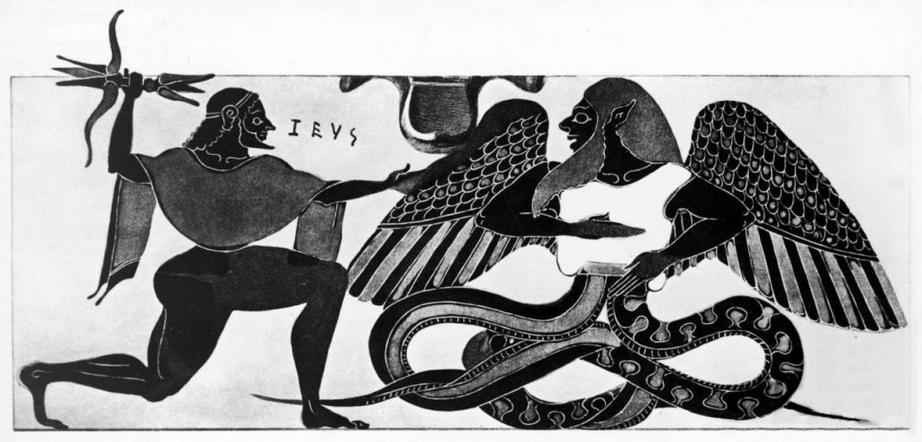
Zeus in combat with Typhon. Detail lifted from a ceramic Chalkidian hydria, c. 540-530 BC. CC0
Over and over again, texts in the Kolbrin’s Egyptian and Celtic books prophecies the Destroyer’s return, giving it many different names: the Sky-monster, the Scorcher of Heaven, the Day of Visitation, the Revenging Dragon, the Days of Disaster, the Great Trial, the Days of Doom, the Doomshape, the Frightener, the Doomdragon; and their precise descriptions of world conditions when the Destroyer returns could well refer to our own time.45
‘It will come in a hundred generations…’ The Kolbrin says that at one time mankind divided the year into ‘a Summer half and a Winter half, with a great year circle of fifty-two years, a hundred and four of which was the circle of The Destroyer.’46 This kind of knowledge implies that someone somewhere had been observing the Earth long enough to record the Destroyer’s huge orbit.
Were Kima and the Destroyer one and the same? In the Kolbrin’s Book of Gleanings, a Sumerian-based account of the Great Flood describes ‘the Destroyer, newly released from the confines of the sky vaults’ 47 raging about the Heavens accompanied by a second destructive force, which sounds much like the double entity Kima; on other occasions the Destroyer is referred to as a single force.
The Sphinx’s head remodelled
If the Sphinx’s ‘voice’ was an early warning system, did the mechanism become redundant as centuries passed? Did the Egyptians forget how to operate it? Did the head itself (tall pointed ears and long nose, if it was a jackal) suffer damage from earthquakes and interference by man ̶ or did the mechanism simply wear out? Was that why the head was remodelled?
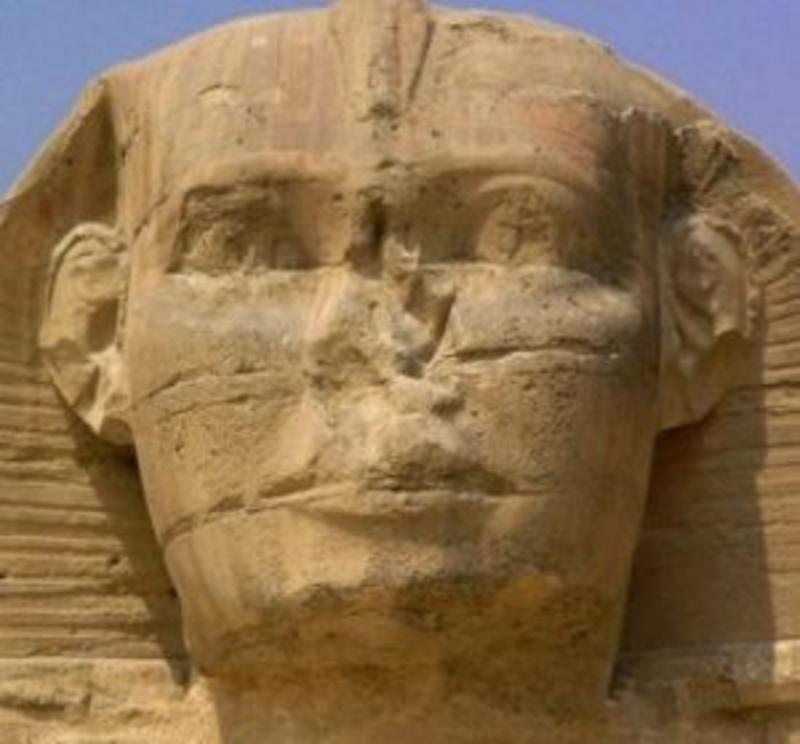
The Great Sphinx of Giza. Credit: Hedwig Storch. CC BY-SA 3.0.
Robert Temple has much to say in The Sphinx Mystery about the re-carving of the Sphinx’s head. He bases his analysis on an 1897 article by the German Egyptologist Ludwig Borchardt:
‘During the century and a half of chaos, floods, drought and famine of the terrible time known as the First Intermediate Period when the government collapsed and mobs ran amok smashing everything in their rage, the head of Anubis must have been drastically mutilated… When order returned under the Middle Kingdom and the Twelfth Dynasty was established… the third king of that dynasty took an interest in the mutilated statue of Anubis. That king was Pharaoh Amenemhet II. Because the head of Anubis was ruined beyond repair, he had a new and smaller head carved out of the neck. That head was a human head, and its face was his own.’
If you look at the upward-turned face of the Giza Sphinx set beside the upward-turned face of the Amenemhet II Tanis sphinx in the Louvre Museum in Paris (apparently this pharaoh adored sphinxes) the resemblance in ears, face shape, eyes and mouth is remarkable.
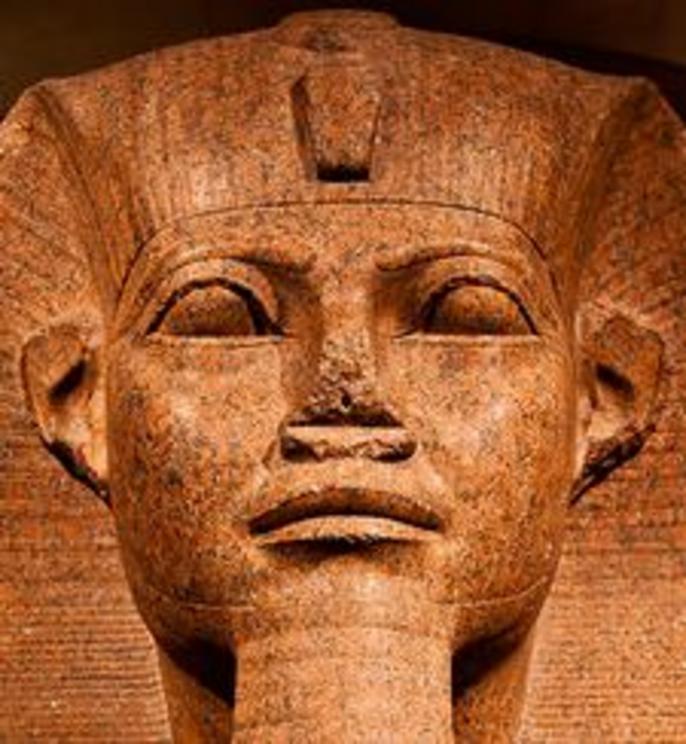
Above: The Great Sphinx of Giza. Below: the Amenemhet II Tanis sphinx in the Louvre, Paris
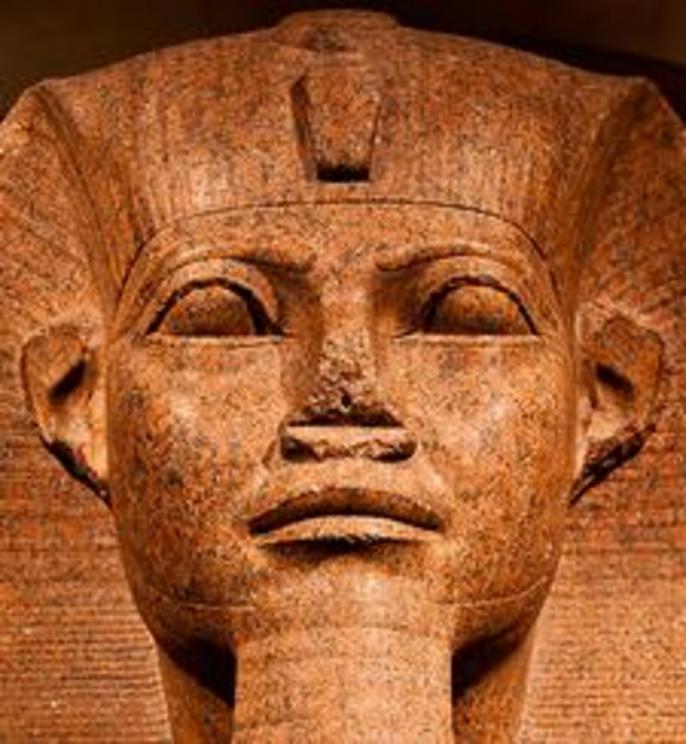
The Great Vault and the Hall of Records
The ‘Great Guardian’ snippet finishes, ‘…as is written in the Great Vault’. Could this be another name for the Hall of Records ̶ a legendary chamber said by ancient writers to house early Egyptian records inscribed with the history of the lost civilisation of Atlantis?48 The Hall of Records has become every Egyptologist’s Holy Grail. It is intriguing that the Dream Stela shows the Sphinx set on a square pedestal with a central doorway and recessed decoration (see drawing below). Robert M. Schoch and Dr Thomas L. Dobecki have used ground-penetrating radar to show that there are indeed cavities beneath the Sphinx, but to date, the Hall has not been found.49
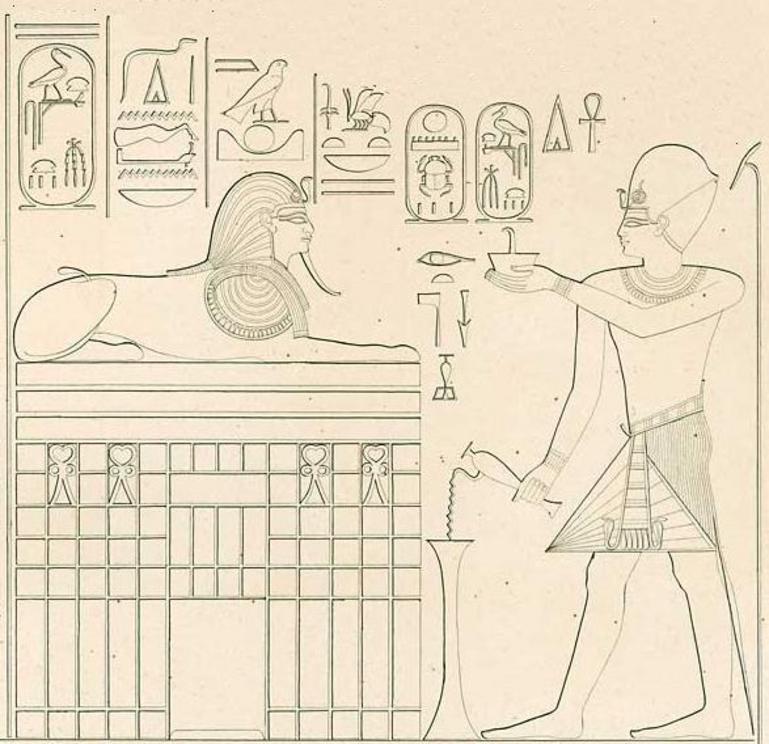
Thutmose IV and the Sphinx, by Karl Richard Lepsius (Denkmaeler aus Aegypten und Aethiopien).
The Kolbrin, now just a patchwork of books and bits of books, was once a vast collection of scrolls and ring-bound volumes of the Old Religion known as ‘the Sacred Records’. Originally it comprised one hundred and thirty-two scrolls and five ring-bound volumes which made up The Greater Book of the Egyptians and The Lesser Book of The Egyptians.50 A chapter in the Book of the Sons of Fire records how four complete sets of the Greater Book and the Lesser Book were put in ‘Great Arks’ inside four masonry casings which were removed to ‘the four quarters of the Earth’ and watched over by ‘Guardians’.51 Later, when civil war split apart the Egyptian religious institutions and the Old Religion was threatened with annihilation, a complete set of Sacred Records was removed from the Eastern Quarter and smuggled out of Egypt.52
Could Giza be one of those ‘quarters’? If so, then a complete copy of the Kolbrin’s Egyptian Books in their original language might even now be lying deep underground among other records, guarded over by that mysterious Great Guardian, Rakima, which we know as the Great Sphinx.
For full references please us source link below

